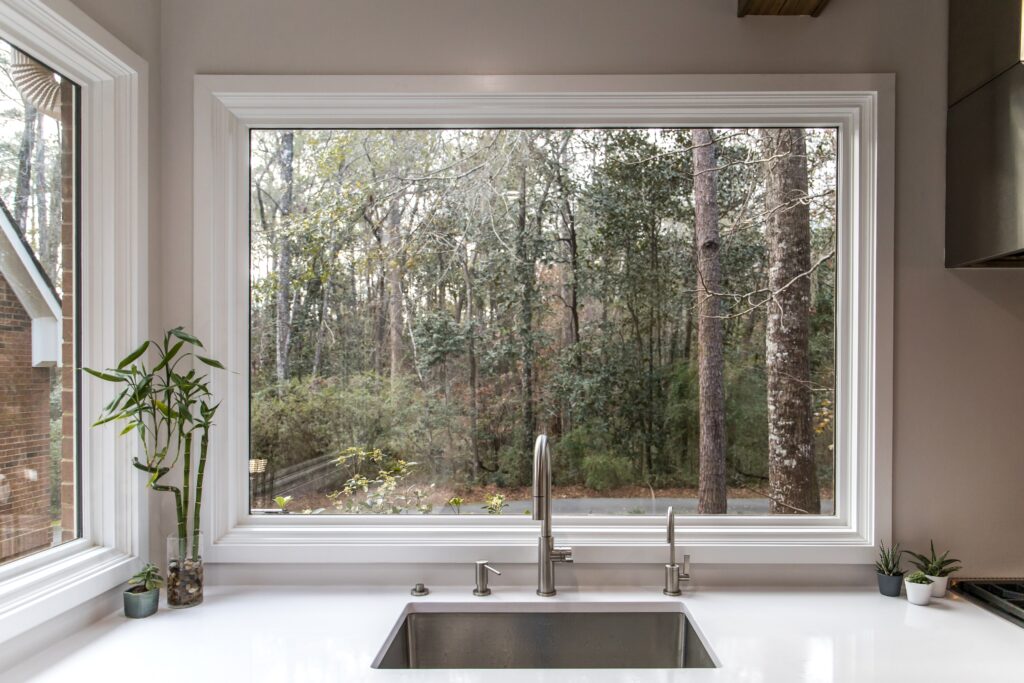Is a Large Picture Window Right for Your Home?

Thinking about upgrading your windows? A large picture window might be just what your home needs. These big, fixed-pane windows don’t open—but they make a bold statement by framing beautiful outdoor views, flooding your space with natural light, and giving your home a sleek, open feel.
Homeowners love them for their ability to bring the outside in while adding major visual appeal. In this article, we’ll break down the pros and cons, where they work best, what to know about energy efficiency and privacy, and how to decide if a picture window is the right fit for your space.
Table of Contents
- What Is a Picture Window?
- Pros of Installing a Large Picture Window
- Potential Drawbacks to Consider
- Is It Right for Your Home Style and Layout?
- Energy Efficiency and Glazing Options
- Privacy, Light Control, and Window Treatments
- Cost of a Large Picture Window
- Alternatives to Large Picture Windows
- When to Call a Pro
What Is a Picture Window?
A picture window is a large, fixed pane of glass that’s designed to give you an unobstructed view of the outdoors—kind of like a picture frame for your yard, garden, or whatever scenery your home has to offer. Unlike windows that open or tilt, picture windows are stationary, which means they don’t provide ventilation. But what they lack in airflow, they more than make up for in natural light and visual impact.
So how does a picture window differ from more traditional styles like casement or double-hung windows? Casement windows open outward like a door, and double-hung windows slide up and down. Both are great if you want airflow. Picture windows, on the other hand, are all about the view. No screens, – just a clean, clear sheet of glass that lets sunlight pour in and makes any room feel more open.
Picture windows come in a range of sizes, from modest accent windows to full wall-to-wall glass panels. Frame materials can vary too—vinyl and fiberglass are popular for their energy efficiency and low maintenance, while wood offers a more classic or custom look (though it may require more upkeep). Some homeowners even mix materials to match their home’s style or boost performance. Whether you’re going for modern minimalism or cozy charm, there’s a picture window setup to suit your space.
Pros of Installing a Large Picture Window
There are plenty of reasons homeowners love picture windows —and not just for the aesthetics. Here’s why a big, fixed window might be a smart (and stylish) move:
1. Maximizes Natural Light
One of the biggest perks of a picture window is all the natural light. These windows act like a giant skylight on your wall, brightening up your space during the day and making rooms feel bigger, warmer, and more inviting. If your home tends to feel a little dark or closed-in, a large picture window can change the vibe.
2. Enhances Outdoor Views
Whether you’re lucky enough to have mountain views, a tree-lined backyard, or even just a charming garden, picture windows let you enjoy the scenery without stepping outside. With no frames or grids to get in the way. They’re perfect for soaking in sunsets, watching the snow fall, or just keeping an eye on the kids while you sip your coffee.
3. Boosts Curb Appeal and Home Value
From the outside, a large picture window adds a modern, polished look to your home’s exterior. Inside, it creates a striking design element that instantly elevates your space. And if you ever decide to sell? Buyers love natural light and open views—both of which can bump up your home’s value and make it stand out on the market.
4. Energy Efficiency (When Properly Glazed)
Worried about heat loss or blazing sun? Modern picture windows are way more energy-efficient than you might think. Look for double- or triple-pane glass with low-E coatings and insulating gas fills. These upgrades help regulate indoor temperatures, cut down on energy bills, and make your home more comfortable year-round.
5. Low Maintenance (No Moving Parts)
Since picture windows don’t open or close, there’s less to clean, less to fix, and fewer parts that can wear out over time. A quick wipe-down every now and then, and you’re good to go.
In short, if you’re looking to brighten your space, enjoy the view, and add some serious style points to your home—all with minimal upkeep—a large picture window is definitely worth considering.
Potential Drawbacks to Consider
While large picture windows can transform your space, they’re not without a few trade-offs. Before you commit to installing one, it’s worth thinking through some of the potential downsides—just to make sure it’s the right fit for your home and lifestyle.
1. No Ventilation (Non-Operable)
Since picture windows don’t open, you won’t be getting any fresh air through them. That might not be a big deal if you have other operable windows nearby, but it can be a downside if you’re relying on natural airflow to cool off a room or keep things fresh. If you love a breeze or live in a climate where airflow is key, you’ll want to pair your picture window with other windows that do open.
2. Possible Heat Gain or Loss if Not Energy-Efficient
A giant pane of glass can be a weak spot when it comes to insulation—especially if the window isn’t energy-efficient. Without the right glazing and sealing, you might feel the summer heat baking through or lose precious warmth in the winter. Thankfully, modern picture windows can be built with high-performance glass, but it’s something to watch out for when shopping.
3. Privacy Concerns
More glass means more visibility—from both sides. A large picture window can put your living space on full display, which may not be ideal if your home faces the street or a close neighbor. If privacy’s a concern, you’ll want to think about window treatments (like blinds, shades, or frosted film) or strategic landscaping to help block unwanted views while still letting in the light.
4. Cost of Installation and Glass
Picture windows can get pricey, especially if you’re going big or customizing the size and frame. The glass itself is a major cost factor, particularly if you’re opting for energy-efficient upgrades. Plus, installation might involve cutting into your wall or making structural changes, which can drive up labor costs. It’s definitely an investment—but one that can pay off in style and home value.
5. Requires Structural Considerations
Speaking of cutting into walls—adding a large picture window isn’t always as simple as it sounds. You may need extra support built into the wall to hold the weight of the glass and frame, especially if you’re replacing a smaller window or creating a brand-new opening. That means bringing in a pro to assess your home’s structure and make sure everything is safe and up to code.
So, while large picture windows are gorgeous and full of benefits, they do come with a few challenges. As long as you’re aware of what’s involved, you can plan ahead and make sure the final result is both beautiful and functional.
Is It Right for Your Home Style and Layout?
Large picture windows look amazing—but they don’t work in every home or every room. Before you start daydreaming about wide-open views, it’s a good idea to think about how a picture window fits into your home’s overall style and layout.
Best Home Styles for Picture Windows
Picture windows tend to shine in homes with clean lines and open spaces. If your home has a modern, ranch, or mid-century vibe, you’re in luck—these architectural styles were practically made for big, dramatic windows. In fact, picture windows are often used as a signature design element in those styles, helping to blur the line between indoors and out.
Even in more traditional homes, a well-placed picture window can add a fresh, updated touch—as long as it doesn’t clash with the overall aesthetic. It’s all about balance.
Ideal Locations in the Home
So where does a picture window work best? Anywhere you want to bring in light or show off a great view. Here are a few perfect spots:
- Living rooms – Create a bright, welcoming gathering space
- Dining rooms – Set the mood with natural light and an outdoor backdrop
- Stairwells or landings – Add architectural interest and daylight to otherwise dark areas
- Bedrooms – If privacy isn’t an issue, a picture window can make your room feel like a peaceful retreat
- Home offices – A little sunshine and a relaxing view can go a long way when you’re working
Just be sure to think about the direction the window will face. South- or west-facing windows can bring in beautiful light—but also heat. North-facing windows offer more consistent, diffused light throughout the day.
When It Might Not Be a Good Fit
As much as we love them, picture windows aren’t always the best choice. If you live in a historic home, for example, a giant modern pane of glass might clash with the original architecture. In that case, you may want to consider a more classic window style that complements your home’s character.
Also, if you’re working with a small room, a large window could overwhelm the space or limit your wall space for furniture and storage. And if your view isn’t great, it might not be worth showcasing with a floor-to-ceiling pane of glass.
At the end of the day, a picture window can be a stunning addition—but only if it makes sense with your home’s style, layout, and needs. If all the pieces fit, it can completely transform the space.
Energy Efficiency and Glazing Options
Picture windows are gorgeous—but if you’re not careful, they can also be energy hogs. Because they don’t open and are often quite large, they can let in a lot of sunlight and heat. Luckily, there are a few key features you can look for to make sure your picture window is energy-efficient all year long.
Double- or Triple-Pane Glass Is a Must
Gone are the days of single-pane windows that let your heating and cooling literally fly out the window. If you’re investing in a large picture window, make sure it’s at least double-pane—or even better, triple-pane. Multiple panes of glass act like insulation, creating barriers that help keep indoor air in and outdoor air out. They’re a huge upgrade when it comes to cutting down on heat transfer, reducing noise, and keeping your home more comfortable.
Low-E Coatings and Gas Fills Make a Big Difference
If you’ve never heard of Low-E (low-emissivity) coatings, here’s the quick version: it’s a super-thin, invisible layer applied to the glass that reflects infrared light. That means your home stays cooler in the summer and warmer in the winter, without sacrificing that big beautiful view.
Then there’s gas fills—specifically argon or krypton gas that’s sealed between the glass panes. These gases are denser than air and add an extra layer of insulation. Together, Low-E coatings and gas fills turn a regular window into a high-performance energy saver.
Tips for Year-Round Efficiency
Want to make sure your picture window works hard no matter the season? Here are a few things to keep in mind:
- Choose the right glass for your climate. Some Low-E coatings are better at reflecting heat, while others help retain it—so be sure to ask your window supplier which option suits your area.
- Install with care. Even the best window won’t perform well if it’s not installed properly. A professional install ensures a tight seal and helps prevent drafts.
- Consider window orientation. South- and west-facing windows bring in the most sunlight and heat, so if your new picture window will face one of those directions, prioritize sun control features like Low-E glass or window shades.
- Add insulating window treatments. If you live in a particularly hot or cold area, pairing your picture window with curtains, blinds, or cellular shades can give you more control over indoor temps.
So yes, picture windows can be energy-efficient—you just have to choose the right glazing and features. With the right combo of panes, coatings, and gas fills, you’ll enjoy those dreamy views without paying for it in sky-high energy bills.
Privacy, Light Control, and Window Treatments
One of the biggest perks of a large picture window is all that natural light—but with great light comes great visibility. And while soaking up the sun and enjoying the view is amazing, you probably don’t want the whole neighborhood watching you binge-watch TV in your pajamas.
Luckily, there are plenty of ways to keep your space bright and private, without sacrificing style.
Blinds, Shades, and Film Options
Let’s start with the obvious: window treatments. You’ve got a ton of options to control both light and privacy:
- Roller shades are sleek, minimal, and easy to raise and lower depending on the time of day.
- Cellular shades (aka honeycomb shades) offer a clean look and add an extra layer of insulation.
- Motorized blinds are great for hard-to-reach windows—and let’s be honest, they’re also just cool.
- Sheer curtains give you soft light and a little privacy during the day without totally blocking the view.
- Window films are another solid option—they stick right to the glass and come in everything from frosted to mirrored finishes. They’re especially handy if you want daytime privacy but still want the light to shine through.
Landscaping or Tinting for Privacy
Sometimes the solution isn’t on the window—it’s outside of it. Strategic landscaping can offer privacy without blocking your view completely. Think: tall shrubs, ornamental grasses, or a row of trees placed just right. You get your light, your view, and a little bit of a privacy buffer.
There’s also window tinting, which works similarly to sunglasses for your home. Tinted windows can reduce glare, block UV rays, and limit visibility from outside during the day. Plus, modern tints come in a variety of shades and finishes, so you’re not stuck with the dark, mirrored look unless you want it.
Balancing Light and Privacy Without Sacrificing Style
The key here is finding the right balance for your space. Want light but don’t want to feel exposed? Go with layered treatments—like combining sheer curtains with blackout shades or pairing film with decorative drapes.
You can also plan your design so the picture window faces a more private part of your property, like a backyard or garden, instead of a busy street.
At the end of the day, picture windows don’t have to be an all-or-nothing choice between beauty and privacy. With the right setup, you can enjoy all that natural light, protect your personal space, and keep your home looking stylish.
Cost of a Large Picture Window
Let’s be real—large picture windows aren’t cheap, but they can be totally worth it if you’re going for that open, airy vibe in your home. Whether you’re dreaming of a massive window that frames your backyard like artwork or just want to flood your living room with natural light, here’s what to know about the cost.
Average Price Range (Materials + Labor)
On average, you’re looking at $800 to $3,000 or more for a large picture window, depending on the size and quality. That includes both the window itself and professional installation. Go big or go custom, and the price can easily creep past $5,000. But keep in mind, it’s a one-time investment that can add serious wow-factor (and resale value) to your home.
Factors That Impact Cost
Several things can drive the price up—or help keep it in check:
- Size: No surprise here—the bigger the window, the more you’ll pay. A small-ish picture window will cost less than a wall-spanning one that needs extra framing and structural support.
- Framing material: Vinyl is generally the most budget-friendly, while wood and fiberglass tend to cost more but offer added durability or aesthetics.
- Glass type: Want double-pane with Low-E coating and gas fills for energy efficiency? That’ll cost more upfront, but it’s a smart long-term choice. Specialty glass like tempered or laminated adds to the price too.
- Custom shapes or designs: If you’re going for something other than the standard rectangle (like an arch or unique grille pattern), expect to pay a premium.
- Labor: The complexity of the installation can affect the price. Replacing an existing window is often cheaper than cutting a new opening in your wall.
Long-Term Savings with Energy Efficiency
Here’s the good news: if you invest in energy-efficient features like double- or triple-pane glass, Low-E coatings, and insulated frames, your new picture window could actually save you money in the long run. It helps reduce heat loss in the winter and keeps your home cooler in the summer, meaning lower energy bills all year round.
Plus, some energy-efficient upgrades may qualify for rebates or tax credits—so it’s worth checking with your installer or local utility company.
Alternatives to Large Picture Windows
If a huge picture window feels a little too bold for your space or you want something with a bit more functionality, there are plenty of stylish alternatives that still bring in light and enhance your view without going all-in on one massive pane of glass.
Bay or Bow Windows
Bay and bow windows are like picture windows with a twist—they project outward from your home, creating a cozy nook or extra floor space inside. Bay windows usually have three panels with one large center window flanked by two smaller ones, while bow windows curve gently with four or more panels. Both options add architectural interest and allow for great panoramic views. Plus, since the side windows often open, you get the bonus of ventilation—something picture windows don’t offer.
Sliding or Fixed Casement Combinations
If you like the idea of a large window but want to add some airflow, consider pairing a fixed picture window with sliding or casement windows on the sides. This combo gives you the best of both worlds—an uninterrupted central view with the ability to open the side windows when you want fresh air. Sliding windows are easy to operate and great for casual ventilation, while casement windows crank open outward and can catch breezes from different angles.
Transom Windows for Added Light
Sometimes all you really want is a little extra light without making major changes. Enter transom windows—those small, horizontal windows placed above doors or larger windows. They’re perfect for letting in natural light while keeping privacy and wall space intact. Transoms can also add a classic, elegant touch to your room’s design and make ceilings feel higher and rooms more spacious.
So, whether you’re after more airflow, a unique architectural feature, or just a subtle light boost, there’s a window style out there that’s right for you. Alternatives to large picture windows let you customize your space exactly how you want it.
When to Call a Pro
Thinking about tackling a large picture window install yourself? While some DIY projects are totally doable, when it comes to big windows, there are definitely times it’s best to call in the experts. Here’s when you should bring a pro on board to make sure everything goes smoothly—and safely.
Structural Support Needs
Big picture windows aren’t just about glass—they also need strong support. Cutting a large opening in your wall can affect your home’s structure, especially if it’s a load-bearing wall. A professional will know how to add the right beams or headers to keep things safe and sound. Trying to guess or wing it could lead to costly damage down the line, so don’t skip this step!
Custom Fitting and Framing
Every home is different, and rarely are picture windows one-size-fits-all. Your pro will make sure the window fits perfectly, and that the framing is solid and level. Custom windows, especially oddly shaped or oversized ones, require precision that comes from experience. A good installer will handle all the tricky measuring, cutting, and framing so you don’t have to stress.
Professional Glazing and Insulation for Maximum Efficiency
You want your picture window to look amazing and perform well. That means flawless glazing and insulation to keep drafts, moisture, and heat loss at bay. A pro has the right tools and materials to do this properly. Poorly glazed or insulated windows can lead to fogging, water leaks, and higher energy bills.
In short, while a picture window can be a stunning upgrade, the installation isn’t always straightforward. Bringing in a professional helps ensure your window looks great, lasts for years, and keeps your home comfy and efficient.
Final Thoughts
Large picture windows bring in loads of natural light and frame beautiful views. But like anything, they come with a few trade-offs—like no ventilation, privacy concerns, and upfront costs.
Before you dive in, it’s important to weigh the pros and cons, think about your home’s layout, your budget, and what you want to get out of your windows in terms of energy efficiency and style.
If you’re unsure whether a big picture window is the right fit, don’t hesitate to chat with a window expert. They can help you figure out the best options for your space and make sure your new window looks amazing while keeping your home comfortable and efficient.

Anna has over six years of experience in the home services and journalism industries and serves as the Content Manager at MyHomePros.com, specializing in making complex home improvement topics like HVAC, roofing, and plumbing accessible to all. With a bachelor’s degree in journalism from Auburn University, she excels in crafting localized, comprehensive guides that cater to homeowners’ unique needs. Living on both coasts of the United States has equipped her with a distinctive perspective, fueling her passion for turning any house into a cherished home through informed, personalized decision-making.








